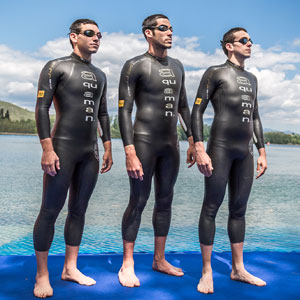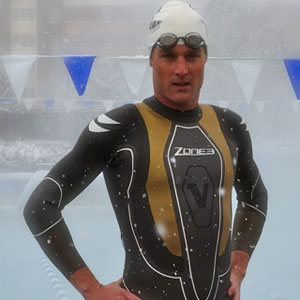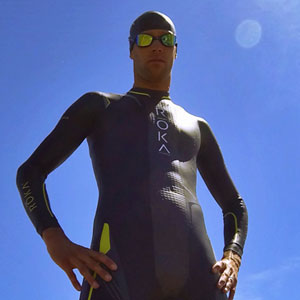Aquaman

Aquaman is new tech, but old school. Aquaman has been around as long as I have in the tri wetsuit scene, and that's a long time. If you ask Aquaman's founder, Xavier Mérian, it's been around longer than I have. But I have definitive proof that I was the first! Take that!
But seriously, this august French company is kind of like Milk of Magnesia or Arm & Hammer Baking Soda. It's been around so long you kind of take it for granted. It's not sexy anymore. We're too familiar with it. Let's get onto the new thing. Aquaman was hot when Christie Brinkley was hot. Aquaman was hot when Kurt Cobain was still alive and rockin'.
Aquaman, unlike Cobain, is still alive and rockin'.
These folks and I share a common history that is almost unmatched in triathlon wetsuit manufacture: we each had our own factories, variously in France (them) and America (us). We each learned how to make wetsuits. This kind of fast-response R&D – an hour between thinking something up and seeing the result of your thought in front of you – pushed both our brands to the head of the class, them in Europe, us (Quintana Roo) in the U.S.
Why do I call them old school? If you look at the way the zipper is built into the suit, you can see twin rows of double needle walking foot stitch lines. Old QR suits looked the same way. But Aquaman uses a neck closure that's better than the old 90s era QR suits, and this represents a melding of old and new methods that make these suits special.
There is another way these suits are old school and this is the first of a couple of old school manufacturers I'm writing about next. When you look at the bottom of this suit, at the ankles, there's nothing fancy here. It's just 5mm rubber down to the low calf and you pull the suit off in transition, it pops off, no problem, that's it. There's no CFD analysis of how the water flows over the flotational hydrostructure. No axial rotation around the negative buoyancy chest expansion panel. Just rubber, baby. You jump into the water and you don't even swim in it. You paddle it.
Mind, it's not just rubber. Aquaman uses a lot of premium rubber from Yamamoto: Aerdome, #39, GIGA #40, and in the Cell Gold (we'll get to that) SCS smoothie inside and out. But even that's kind of old school, as that SCS 2-side rubber has been around since the 90s. I played with that myself and it has advantages I'll describe.
You can get this rubber.

You just spec the rubber. If you're willing to pay for the rubber you just spec it and that's that. Nothing proprietary here. So how hard can this suit be to make? Well, it's not that simple. It's in the patterns. And this takes us back to the beginning, when Aquaman was learning how to make wetsuits in its own factory – diving wetsuits – founded in 1976. When I first thought of the modern triathlon wetsuit and what it should look like I immediately flashed back to my high school days living in Lake Tahoe, on the water, with my own broken down ski boat, and a secondhand glued & blindstitched farmer john – out of black smoothskin – that was contoured and form fitting and went on like a glove. Making these was Aquaman's background, before it ever made its first triathlon wetsuit. It knows how to do this.
Let me give you an example of this, and I'm going to try to decode Aquaman for you because I don't think it does the best job at messaging. So, the pattern example: the "flexible zipper." This is an Aquaman trade feature. But zippers aren't flexible. Grab the back of your wetsuit, one hand on each end of the zipper, and pull. No flex. It doesn't flex. So, is Aquaman engaging in creative puffery? No. The reason Aquaman's suits seem old style in their zipper construction is because that zipper takes the scenic route in getting from one end to the other. It's humpy. Like a roller coaster. That's by design. You can see this in the image above. If you don't like suits with a neck that chokes you in front, that's the point of this style of zipper, and it's not high tech. But it is effective. It's in the pattern or, at least, it's inherent in that style of construction. Our old QR suits did the same thing. If you bend over at the waist, the rolls of zipper flatten out. You have that extra room in abeyance, in case you need it.
Almost all the other wetsuit companies – 2XU, Nineteen, ROKA, Zone3, on and on – use a much cleaner looking way of inserting the zipper into the suit. They double needle or zigzag the zipper onto the zipper flap and then blindstitch the flap into the back of the wetsuit, and you won't see any stitching protruding through the suit to the outside. This also allows, in my opinion, for a stronger zipper base. But you can't make this kind of "flexible zipper" very easily when you do that. I don't think Aquaman's zipper base is a strong as in these other suits, but I also don't think it needs to be, because the zipper "expands" when it's placed on stretch and that keeps the zipper base from stress. (I harp on the zipper base because it's a common place for failure in wetsuits).
Just like a bike company might make 2 geometries of road bikes – one for long legged fellows and one for long torsoed fellows (or ladies) – Aquaman makes 2 patterns. Rather than one fit style, but with sizes in both standard and tall (i.e., Medium, Medium Tall, Large, Large Tall), the Cell Gold, Bionik and ADN are all the same patterns and all are XS, S, M, and so forth.
Then there's the ART. It's a different pattern and I'll get to that.

The top of Aquaman's wetsuit line is the "Cell Gold". It has one thing no other wetsuit can boast that I know of: smoothskin both sides, inside and out. Technically, the suit can claim that the jersey (the fabric on the inside) won't absorb water, so it'll be lighter, so you'll go faster because you won't be dragging that water around. But the material is also slightly heavier. So I think that's a wash. The suit does go on and come off very easily, and I think that is this model's chief value. But it's a little weird, if you're not used to it and you just can't get used to new paradigms. What this suit is beyond everything else is warm – warmer than just about any other wetsuit you'll consider. If you need a specifically warm suit, this is your choice. If you want a fullsuit because of the speed, but you don't want it warm, I would not choose this suit.
This suit – the Aquaman Cell Gold – is what I think Jordan Rapp would be swimming in if he was not swimming in his ROKA Maverick Pro. This, just based on my discussions with Jordan over the years. He loves this suit.
One thing he loves about it is the reverse zipper and this is in all Aquaman's suits. And I love the reverse zipper too, once the suit is on. My only reticence with this technology is my 2 broken collarbones – 1 with a plate still in there – and my old man's shoulders and lack of flexibility. It's just a little tougher to get it on. But I will say one thing: if the suit is a tight fitter, it is in a way easier to zip the suit up – er, down – that is to say, it's easier to close the zipper in preparation for swimming, by clasping the zipper at the top and zipping it down. So I guess I'm conflicted on this. I would not let the style of zipper be the deciding factor in whether I used a specific wetsuit.
The Cell Gold is a $650 suit, and if you just don't want to spend that amount of money, or if you don't want a suit that warm, the Bionik is similar to that suit without the SCS smoothskin on the inside of the suit. And it's $490. It's a top rate suit at $490.
The ADN is the lowest price fullsuit and it sells for $320. Why would you want the Bionik over the ADN? The Bionik is made primarily of stretchier rubber, specifically Yamamoto #40 rather than the #39 rubber that goes into the ADN. I don't think this is necessarily a plus. The Bionik is going to be more forgiving, and if you don't have a standard morphology any #40 suit is a Gumby suit. It's flubber. It's Silly Putty. The Orca Alpha has the same kind of thing going on. It's an extremely flexible suit. Both these suits are. But if you're a great fit in an Orca 3.8 or, in Aquaman, the ADN, these might actually be better suits for you, cost no object. Suits made entirely of #40 must fit pretty snug or they're prone to take in water as the swim progresses. If the ADN fits you, it's a great bargain.

Now let's talk about the strange and compelling suit that is the ART. It's supposed to appeal to those who want a snug fit but still want shoulder flexibility. If you want a wetsuit that will not take in water – almost a dry suit – because of an adroit set of patterns, this is what this suit is supposed to do. But if you look at the size chart, it seems to be built in the "short" sizes, as in, if all the other suits were built for guys like Jordan Rapp (tall and rangy) this is the suit that, according to the size chart, you'd buy if you were built like a fireplug. If you're built like a T Rex the ART is your suit. Got it?
At QR, we built standard and short sizes, the reverse of what most wetsuit companies build today. Our standard sizes were our tall sizes. So, we built Medium and Medium Short, Large and Large Short. I could never swim in one of our short sizes. That would mean I can't swim in an ART.
But, in fact, I actually fit very nicely in the ART. These suits have longer torsos, which I like (because I am marginally long in the torso). The suit is a bit short in the arms and legs for me, and if you look at the pic of Tyler Butterfield in the Zone3 review that's kind of what I look like in an Aquaman ART. This is a strange, quirky, very appealing, wetsuit. You can tell from the image above (no, that's not me) that this is a non-standard wetsuit. How they got the idea for a pattern like that is God's own mystery. But sometimes I'd go on the back, look at the patterns my guys came up with, shake my head and walk back to my office where I belonged. As I said, it's a black art.
The ART is one of my favorite suits to swim in, and for me one of the fastest, within a second per 100 yards of any suit I've been in. It is priced high, at $650, same as the Cell Gold. I think it's worth every penny if you just feel constricted in every suit you've tried. Don't let the size chart put you off. Go by weight, and if you're an inch or two too tall based on the size chart, get it anyway. Just, if you're in between sizes, choose the larger size. This is a snug suit.
Read and see more about Aquaman wetsuits.




Start the discussion at slowtwitch.northend.network